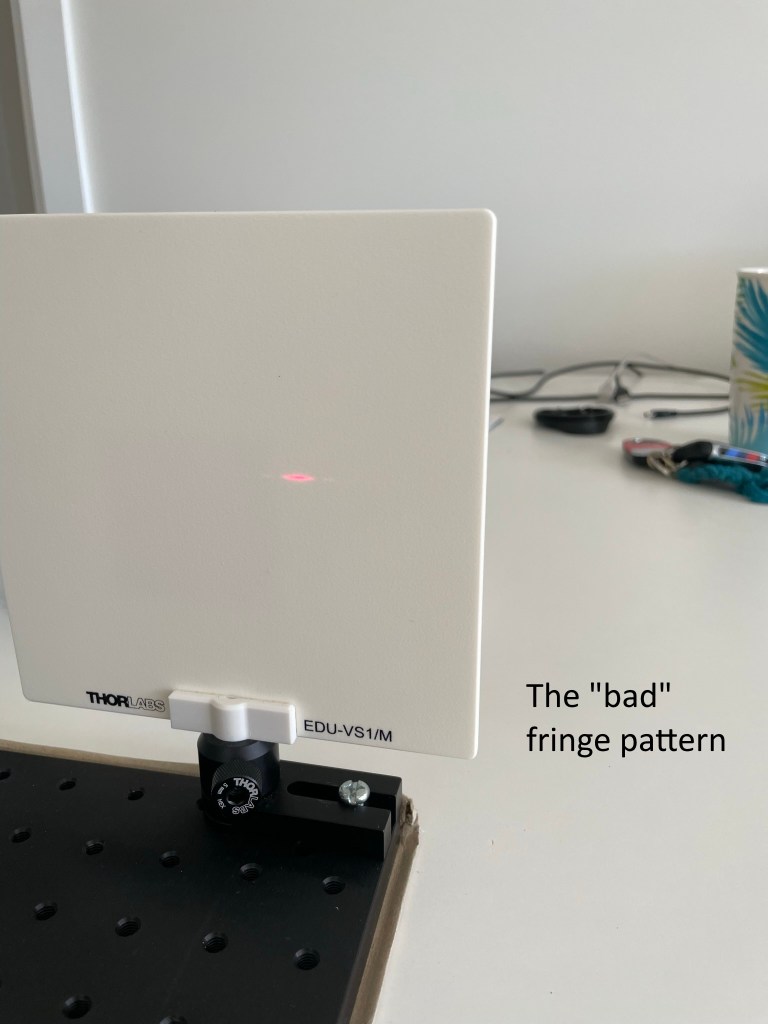Table of Contents
Now that we have learned that light is a wave, let’s explore a few practical things.
Measure the wavelength of the laser
As we have seen before, different lasers have show a different wave pattern and we can use this now to either
- calculate the wavelength of our laser based on the pattern, or
- predict the pattern based on the wavelength.
The only formula we need is \(lambda = frac{yd}{D}\)
where \(lambda\) is the wavelength, d is the length of the slit, D is the distance between the slit and the screen and \(y\) is the distance between the middle and the first minimum.

We know \(d\) and \(D\) and we can measure \(y\) (in fact we did before) and that will give us then \(lambda\)
Diffraction Grating Slide
So the only thing we need to measure is \(y\), which is the distance between the middle and the first minimum. To make life a bit easier, we won’t take the double-slit, but instead a “diffraction grating slide”. This is pretty much just a class that has many slits next to each other (in the case of the 80 lines/mm, this is 12.5 micronmeter, or 12500 nanometer)

The beauty of the grating slide is that it makes the maxima (the bright spots) much brigher and the dark spots much darker, so it’ll be easier for us to measure

Example Measurement

So now I measure
- \(d\) (which is 300 lines/mm, meaning there are 300,000 lines per meter, which makes the distance between them \(1/300000\)
- \(D\), which in my case was 40cm, or 0.4m
- \(y\), which I measured as 6.3cm, or 0.063m
Now I can calculate \(lambda = frac{yd}{D}\), which gave me \(0.000000525\) or \(525 nm\). The laser has a specification of 532nm, so we measured pretty exact 🙂
Measure the thickness of a human hair
Well, first of all, we need some human hairs 😉
Secondly, how would we calculate the thickness of the hair?
Well, the cool thing is that diffraction can happen in many ways. One way we explored is the use of a slit, but diffraction also happens in the same way if the light hits an object, such as the hair. The cool thing is now that our equations still work, with the exception that size of the slit \(d\) is not replaced with the diameter of the hair!!! How cool is that?
So re-writing our equation from above gives us
\(d = frac{lambda D}{y}\)We know D, we know \(lambda\) and we can measure \(y\) once the laser hits the hair and as such we can easily calculate \(d\), which is the thickness of our hair…
How cool is that?
Let’s do this now…
Reference Measurement
Just to make sure we know that we are roughly measuring the right thing, let’s measure something we know how thick it is… Remember the single slit experiment? We know how thick that slit was

It was \(50 µm\) wide, so let’s measure it and see how close we get
I measured
- \(lambda = 532 nm\) (I use the green laser)
- \(D = 1.4m\) (distance between the hair and the screen(wall))
- \(y = 0.015m\) (measured from the middle to the first minima)
This will give us
\(d = 49.65 microns\), so this is very, very close to out 50 microns.
So now we know that we are measuring the right thing 🙂 Let’s finally measure some hair and compare…
Example Measurement
So I measured
- \(lambda = 532 nm\) (I use the green laser)
- \(D = 1.4m\) (distance between the hair and the screen(wall))
- \(y = 0.12m\) (measured from the middle to the first minima)
This will give us
\(d = 53.20\) microns or \(0.0532\) mm
The average hair is 70 to 120 microns thick, ± 20 microns, or has a thickness of 0.08 to 0.12 millimeters. Blonde hair has a lesser thickness due to a weaker middle layer. The process of aging and genetic disorders can lead to a significant reduction in the diameter.
Who has the thinnest/thickest hair?
| Name | Hair thickness |
|---|---|














